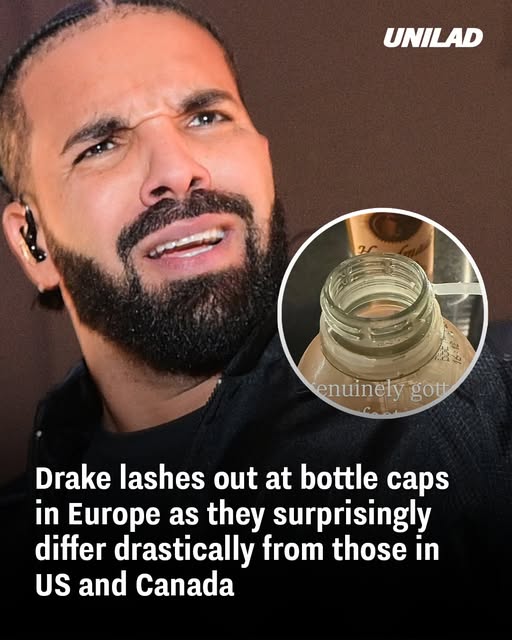Drake recently expressed his frustration with a noticeable change in European beverage packaging. Sharing an image on social media, he commented, “I genuinely gotta ask who is manufacturing the bottle caps in Europe because none of them fully disconnect like the plastic plant needs to rejig the renders cause this is happening everywhere.” His post highlighted the difference in bottle cap designs between Europe and North America.
Understanding the Design Change
The tethered bottle caps Drake encountered are part of a European Union regulation introduced in 2024. This mandate requires that caps remain attached to bottles to reduce plastic waste and prevent littering. The EU identified loose caps as a significant environmental hazard, often found in rivers and seas, and a choking risk for wildlife. By keeping the cap attached, the entire bottle is more likely to be recycled properly.

Public Reaction and Misunderstandings
Drake’s reaction mirrors a broader confusion among visitors to Europe. Many Americans have shared their surprise upon encountering the tethered caps, mistaking them for manufacturing defects. One Reddit user commented, “I hate it so much when it happens. I feel like I can’t continue drinking until I get the cap all the way off lol.” Others thought it was a child safety feature.
Environmental Impact and Industry Response
Despite initial resistance from beverage companies like Coca-Cola, the tethered cap design has been widely adopted across Europe. The change aims to align with the EU’s broader environmental goals, including reducing single-use plastics and enhancing recycling efforts. While some consumers find the new design inconvenient, it represents a significant step towards more sustainable packaging practices.
Drake Criticizes Europe’s Tethered Bottle Caps
Drake recently expressed his frustration with a noticeable change in European beverage packaging. Sharing an image on social media, he commented, “I genuinely gotta ask who is manufacturing the bottle caps in Europe because none of them fully disconnect like the plastic plant needs to rejig the renders cause this is happening everywhere.” His post highlighted the difference in bottle cap designs between Europe and North America. Fans and followers immediately began discussing the post, with many agreeing and others explaining the environmental reasoning behind the change. Some social media users shared memes and jokes about struggling to open the bottles, while others praised the EU for its innovative approach to reducing plastic pollution. The conversation quickly went viral, showing how even small design changes can capture public attention and spark debate about sustainability and convenience.
Understanding the Design Change
The tethered bottle caps Drake encountered are part of a European Union regulation introduced in 2024. This mandate requires that caps remain attached to bottles to reduce plastic waste and prevent littering. The EU identified loose caps as a significant environmental hazard, often found in rivers and seas, and a choking risk for wildlife. By keeping the cap attached, the entire bottle is more likely to be recycled properly. Environmental organizations have supported the initiative, emphasizing that every small step counts toward reducing ocean pollution and protecting marine life. Many European consumers have gradually adapted to the new design, appreciating its long-term benefits despite initial inconvenience.

Conclusion
Drake’s reaction underscores the cultural and practical differences in environmental policies between regions. While the tethered bottle caps may be an adjustment for those accustomed to traditional designs, they reflect Europe’s commitment to reducing plastic waste and promoting recycling. As global awareness of environmental issues grows, such initiatives may become more prevalent worldwide

















